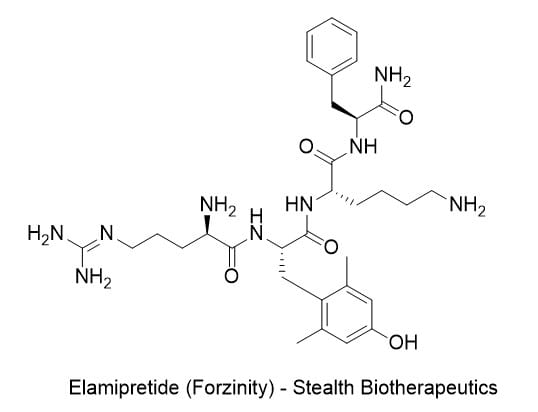From Discovery to FDA Approval: Forzinity Becomes First Therapy for Barth Syndrome
Forzinity (elamipretide) makes history as the first FDA-approved therapy for Barth syndrome. Learn about Hazel Szeto’s discovery, Stealth Biotherapeutics’ development journey, and the clinical evidence supporting approval.
FDA Accelerated Approval Marks a Milestone
On September 19, 2025, the U.S. Food and Drug Administration (FDA) granted accelerated approval to Forzinity (elamipretide HCl), developed by Stealth Biotherapeutics, for Barth syndrome in patients weighing ≥30 kg. This is the first approved therapy for this ultra-rare, life-limiting mitochondrial disorder. Approval was based on improvements in knee extensor muscle strength, a surrogate endpoint considered reasonably likely to predict functional benefit. Stealth also received a rare pediatric disease priority review voucher, with a confirmatory trial required to verify long-term clinical benefit [1,2].
Barth Syndrome: An Ultra-Rare Disease
Barth syndrome is an X-linked genetic disorder caused by mutations in the TAZ gene, which disrupt cardiolipin remodeling in mitochondria. It predominantly affects males, manifesting as cardiomyopathy, skeletal myopathy, exercise intolerance, neutropenia, delayed growth, and early mortality, often before age five. Current estimates suggest roughly 150 individuals with Barth syndrome in the U.S., and until now, no approved therapies were available [2].
Discovery and Company Formation
Elamipretide, also known as SS‑31, MTP‑131, or Bendavia, originates from the Szeto-Schiller (SS) peptide class. These mitochondria-targeted peptides were discovered by Hazel H. Szeto, a pharmacologist at Weill Cornell Medical College. Initially developed as a research tool, Szeto was screening compounds for opioid receptor activity when she discovered that one peptide unexpectedly penetrated cells, targeted mitochondria, increased ATP production, and decreased reactive oxygen species [3].

In 2006, with support from Morningside Venture, Hazel Szeto founded Stealth Biotherapeutics, licensing elamipretide from Cornell. The company began exploring multiple indications, including heart failure, ophthalmic diseases, and neuromuscular disorders, ultimately prioritizing Barth syndrome as its lead rare disease target [3,4,15]. Stealth collaborated closely with academic researchers and the Barth Syndrome Foundation, which supported natural history studies, clinical trial recruitment, and patient advocacy [4,15].
Regulatory and Development Hurdles
The path to FDA approval was long and complex, reflecting the challenges of ultra-rare disease drug development:
- Early Trials: The TAZPOWER/MMPOWER program included phase 2/3 trials and open-label extensions, evaluating endpoints like the 6-minute walk test (6MWT) and knee extensor strength. Some endpoints were supportive, while others narrowly missed significance [12,13].
- Initial FDA Refusal: In 2021, the FDA refused to review a prior submission due to insufficient evidence, underscoring the difficulty of designing robust trials with very small patient populations [11].
- Adaptive Trial Design: Subsequent analyses leveraged natural history comparisons, extended open-label data, and patient-reported outcomes, improving the regulatory submission [10,12].
- Advocacy Efforts: Patient organizations actively urged regulators to consider the urgent unmet need, amplifying community voices for accelerated access [4,15].
This trajectory highlights both the regulatory caution surrounding surrogate endpoints in ultra-rare diseases and the persistence of Stealth and the patient community.
Clinical Data Supporting Approval
- TAZPOWER Phase 2/3 Trial (n≈12): Randomized, double-blind, placebo-controlled trial followed by open-label extension. Primary endpoint (6MWT) narrowly missed statistical significance; secondary endpoint (knee extensor strength) improved, forming the basis for accelerated approval [12,13].
- Natural History Study: Compared elamipretide-treated patients with untreated historical controls, supporting functional and strength benefits [10].
- Mechanistic Rationale: Preclinical studies demonstrated that elamipretide stabilizes cardiolipin, improves mitochondrial function, reduces reactive oxygen species, and enhances ATP production [3].
- Long-Term Observations: Sustained improvements in muscle function and fatigue were reported, with potential cardiac benefit suggested in exploratory endpoints [3].
The FDA concluded that knee extensor strength is a surrogate endpoint reasonably likely to predict clinical benefit, justifying accelerated approval [1].
Implications and Outlook
The approval of Forzinity represents a historic milestone: the first therapy for Barth syndrome and the first mitochondria-targeted peptide approved clinically. While confirmatory trials are still required, the decision reflects a growing regulatory willingness to balance scientific uncertainty with urgent unmet need in ultra-rare pediatric disorders.
Limitations remain: the current label excludes children under 30 kg, though Stealth plans to pursue pediatric expansion and develop a preservative-free formulation [2]. Ongoing post-marketing studies will be crucial to demonstrate long-term functional benefit and secure full approval.
This case exemplifies how mechanistic innovation, persistent clinical development, adaptive trial design, and strong patient advocacy can converge to overcome the hurdles of ultra-rare disease drug development.
Sources
- FDA Grants Accelerated Approval to First Treatment for Barth Syndrome. U.S. Food and Drug Administration. Published September 19, 2025.
- Stealth Biotherapeutics Announces FDA Accelerated Approval of Forzinity (Elamipretide HCl), the First Therapy for Progressive and Life-Limiting Ultra-Rare Genetic Disease Barth Syndrome. Stealth Biotherapeutics. Published September 19, 2025.
- Szeto, H. H.; Schiller, P. W. The Tetrapeptide SS-31 Protects Mitochondria and Cell Bioenergetics. Pharm. Res. 2011, 28, 2669–2679. DOI: 10.1007/s11095-011-0476-8.
- Recent Highlights of Advocacy Efforts. Barth Syndrome Foundation. Accessed April 14, 2025.
- Study Yields Clues to How Drug May Boost Aged Mitochondria. UW Newsroom. Accessed April 14, 2025.
- Sabbah, H. N. Heart Fail. Rev. 2022, 27 (5), 1911–1923. DOI: 10.1007/s10741-021-10177-8.
- Hornby, B.; Thompson, W. R.; Almuqbil, M.; Manuel, R.; Abbruscato, A.; Carr, J.; Vernon, H. J. Orphanet J. Rare Dis. 2022, 17, 336. DOI: 10.1186/s13023-022-02469-5.
- FDA Refusal of Stealth Bio Drug Shows Challenges of Ultra-Rare Disease Studies. MedCity News. Published October 2021.
- Reid Thompson, W.; Hornby, B.; Manuel, R.; Bradley, E.; Laux, J.; Carr, J.; Vernon, H. J. Genet. Med. 2021, 23 (3), 471–478. DOI: 10.1038/s41436-020-01006-8.
- MMPOWER Data Published in Neurology. Stealth Biotherapeutics. Accessed April 15, 2025.
- Advocacy Alert! Barth Syndrome Deserves a Fair Chance! Barth Syndrome Foundation. Published February 28, 2022.
Disclaimer: This article is for informational purposes only, summarizing publicly available sources. It is not medical advice. Patients should consult qualified healthcare professionals for diagnosis, treatment, or participation in clinical trials.